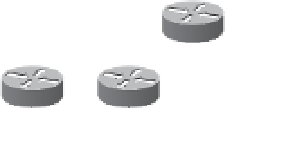Information Technology Reference
In-Depth Information
Network Core
10.3.0.0/16
10.1.0.0/16
10.2.0.0/16
Distribution
router
Distribution
router
Europe
North America
Brazil
10.2.1.0/24
10.2.2.0/24
...
10.3.1.0/24
10.3.2.0/24
...
10.1.1.0/24
10.1.2.0/24
...
Figure 11-17
Route Summarization
Routers in Europe need to know only the summarized route to get to Brazil and North
America, and vice versa. Again, a design best practice is to summarize at the distribution
toward the core. The core needs to know only the summarized route of the regional areas.
Yo u c a n a l s o u s e s u m m a r i z a t i o n t o a g g r e g a t e fo u r c o n t i g u o u s C l a s s C n e t w o r k s a t t h e / 2 2
bit level. For example, networks 200.1.100.0, 200.1.101.0, 200.1.102.0, and 200.1.103.0 share
common bits, as shown in Table 11-7. The resulting network is 200.1.100.0/22, which you
can use for a 1000-node network.
Ta b l e 1 1-7
Common Bits Within Class C Networks
Binary Address
IP Address
11001000 00000001 01100100 00000000
200.1.100.0
11001000 00000001 01100101 00000000
200.1.101.0
11001000 00000001 01100110 00000000
200.1.102.0
11001000 00000001 01100111 00000000
200.1.103.0
It is important for an Internet network designer to assign IP networks in a manner that
permits summarization. It is preferred that a neighboring router receive one summarized
route, rather than 8, 16, 32, or more routes, depending on the level of summarization. This
setup reduces the size of the routing tables in the network.













